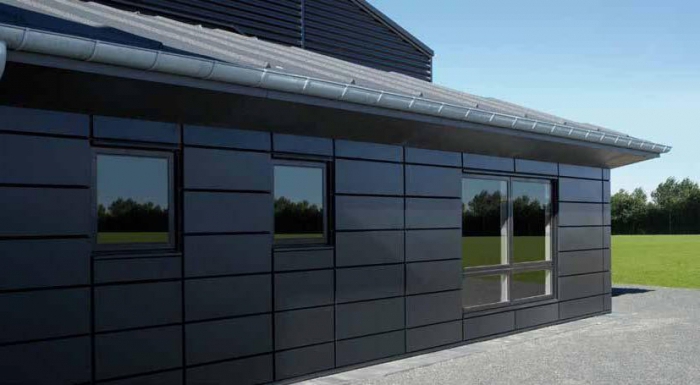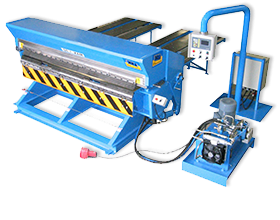Facade cassettes - they are also called metal cassettes - are facing materials that look like completed metal structures, bent at the sides. This type of finishing coating is actively used in ventilated facade systems.
This unique building material is firmly and rigidly mounted on a rivet or self-tapping screw to the surface, which allows to ensure the integrity of the lining throughout the entire operational period. Facade cassettes can be attached in one of two ways: open, when each product is attached with hardware to the supporting frame separately; and hidden when the upper cassette clings to the lower.

Metal structure
Most often produce steel and aluminum facade cassettes. By its design, the product is a box, in the upper part of which there are special holes designed to secure the profile handle. The fastening edge is at the bottom of the cassette.
In addition, the coating in question provides openings for ventilation of the walls, as well as condensate drainage. The manufacture of facade cassettes, depending on the specification, can be carried out in different ways, so they can have different sizes.
At present, piece lining materials are also produced (metal cassettes of square, rectangular or any other arbitrary shape), and linear (in the form of two-, three-meter panels). Often metal sheets are coated with polymers: PVDF, polyester, powder coating.
Advantages and disadvantages
Before talking about what is needed for the production of facade cassettes, we will consider their inherent properties. So, these designs have several advantages, including:
- ease of installation - the cassette facade makes it possible to mask surface irregularities;
- corrosion protection - the applied material with polymer coatings is effectively protected from physical and chemical damage;
- an extensive range of color solutions - through the use of polymers, metal cassettes can be made in any desired color scheme;
- long service life without painting and repair - the coating does not change properties when exposed to atmospheric precipitation and does not fade under the influence of sunlight.
Meanwhile, the facing material in question has its drawbacks. Among them, a relatively high cost should be noted. Compared to other types of finishes, the cassette facade is one of the most expensive. However, due to the lack of wet processes, the use of this technology in most cases is justified.
Using metal cassettes
Such systems are used in residential buildings, administrative and commercial buildings, public facilities for covering ceilings / walls / columns. Often, facade cassettes are used to transform the appearance of shabby, old buildings, in which, after renovation of the facade, the market value can increase several times.

Equipment for the production of facade cassettes
To make such metal structures, modern equipment, including computerized, is required. As a rule, lines of foreign companies are used, since they allow the production of the highest quality products.
In addition, only using such equipment for the production of facade cassettes will it be possible to accurately comply with the required dimensions of the parts, which will subsequently guarantee easy and quick installation of the facing material.The thickness of the initial metal sheet can vary from 0.7 to 1.2 millimeters, with the help of special aggregates it is bent and given the desired shape.
So, what is required for the manufacture of structures?
1. Mechanical or manual guillotine
A foot-operated device designed to dissolve roofing sheet material and cut plastic and non-ferrous metals. It is better to use a mechanical guillotine, which allows you to free the operator's hands for handling the workpiece and facilitate the work of the machine.
The cost of such an aggregate is on average 85 thousand rubles. The package includes two stops with rulers on the sides, a manual feed stop, a retractable front stop (designed for long sheets), an emphasis for cutting at an angle, two front support rods.

2. Bending machine for the production of facade cassettes
Segment bending machine used to bend facing material. It performs its function due to the presence of the main - bending - and pressure beams, each of which is equipped with segments of different widths, and sometimes with knives. Clamping of sheets having different thicknesses is carried out by adjusting the clamping force of the sheet blank. Such a device on average costs from 124 to 200 thousand rubles.
3. Angle cutting machine
A press designed for punching holes in holes and cutting corners. As a rule, it is equipped with both foot and manual drives. On this unit, corners are cut out on the blanks, which are then bent on a sheet bending machine.
To cut a difficult angle and punch a hole in one stroke of the lever, it is necessary to use special cutting dies made individually for each specific product. The cost of such equipment ranges from an average of 24 to 47 thousand rubles.

Among the necessary equipment, you can also include a measuring table used for cutting sheet material.









The management has questions:
1. What is the cost today of kits (electromechanical equipment and automatic). Who is the manufacturer?
2. You can provide a feasibility study (calculation), indicating the number of staff in the shift; types, thicknesses and grades of metal (and if there is information on the price and the nearest suppliers), other consumables, etc.
3. Additional technological equipment, devices, control plates, tables, furniture, measuring and working tools, consumables for commissioning, cassette production and maintenance. Quantity and cost if you supply.
4. Delivery of equipment. If your delivery or transport company, how much will cost us (delivery time if the equipment is already ready), the amount of insurance. And if we come for the equipment. What (if we come) type of transport should I send? The volumes and weight of each component and / or machine. Of course, taking into account the additional ones that I mentioned in Section 3
5. The size of the production room; electricity supply and consumption; foundation requirements for machine tools; lighting, safety. Dimensions and requirements for storage facilities for metal storage and finished goods warehouse. How and what is packaging done.What protects the front layer of cassettes during production, storage, transportation and installation at the facility.
6. The plan for the placement of equipment, taking into account the locations for working areas, machine service areas and driving routes (transportation of workpieces and finished products).
7. Who makes the adjustment of equipment, training (if required) maintenance staff and puts the complex into operation. Price issue.
8. How and at what time is the guarantee and technical support. Price issue.
And of course, is it possible to see all this somewhere at the factory or at the stand.